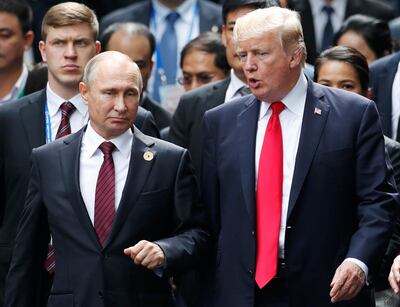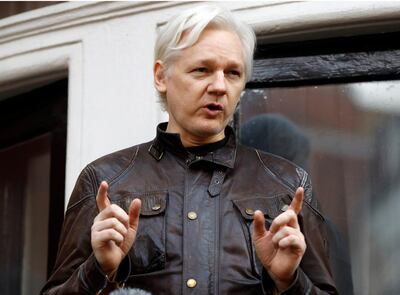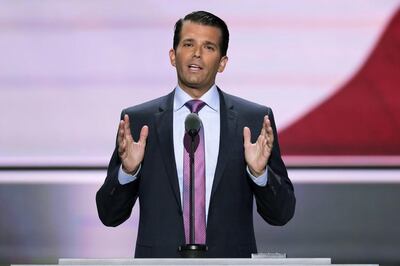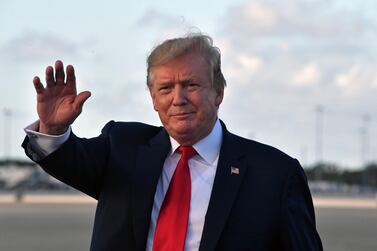Special counsel Robert Mueller's report was long-portrayed in Washington as political.
A witch-hunt, a hoax, a vendetta against Donald Trump, according to the president and his supporters.
What a close reading of Mr Mueller's findings makes clear is that it was nothing of the sort.
It was Russia who years ago targeted Mr Trump, not the former director of the FBI whose inquiries have captivated us for more than two years.
And Russia's information warfare succeeded, helping put Mr Trump in the White House.
The report's best legacy would be to compel US authorities to develop systems more capable of stopping a foreign power wielding such influence on American voters again.
Mr Mueller's mandate was to investigate how this happened and he has done so. But with the focus still on Mr Trump it appears far from clear that such an infiltration campaign could not happen again.

US agencies seem no better prepared now to repel the activities that Vladimir Putin's government and intelligence services deployed ahead of the 2016 race.
The US president has shaped the discourse since. During the investigation he repeatedly condemned Mr Mueller and his team. Post-publication, such noise has again given cover for Mr Putin.
But the Mueller report is forensic and chilling in documenting the lengths that Russia went to.
Not only had Moscow “perceived it would benefit from a Trump presidency,” it “worked to secure that outcome”.
While the investigation did not establish that members of the Trump campaign were part of a criminal conspiracy, it lays out the many contacts it had with Russian individuals and how members of Mr Trump's inner circle attempted to gain access to anything that damaged Hillary Clinton's electoral chances.
It is here that Mr Trump has been sucked in. Having believed Mr Mueller's appointment spelled the end of his presidency, the US president chose to frustrate the inquiry, undermining it in public and asking subordinates in private to write letters and take actions that would insulate him from it. But Russia's work had already been done.
Disinformation and email hacking operations were the primary weapons. Russia's electronic warfare methods were utilised “in sweeping and systematic fashion”, Mr Mueller said.
The innocuously-named Internet Research Agency, based in St Petersburg, sent operatives to the US as far back as June 2014, with at least two female agents, Anna Bogacheva and Aleksandra Krylova, lying on their visa applications about their reasons for entering the country.
Once on US soil they began researching how to gain a foothold over the American mind, with Facebook, YouTube and Twitter their primary pathway. They later added specialists who operated Tumblr and Instagram accounts.
Some of the most heavily redacted sections of the Mueller report concern these activities.
The details have been blacked-out under headings of “Harm to Ongoing Matter” or “Grand Jury”. That suggests crimes already committed by Russian agents or other actors or similar matters not yet disclosed are under investigation ahead of the 2020 presidential election.
Bogacheva and Krylova were the vanguard of the 2016 effort. They led an operation that created social media accounts that pretended to be US citizens, then added social media groups or public pages that falsely claimed to be affiliated with American activists, political groups or grassroots organisations.
They posed as anti-immigration groups, Tea Party supporters and Black Lives Matter advocates.
Collectively, the disinformation effort reached tens of millions of Americans.
The IRA ramped up its activities in 2016, publishing material that supported the Trump campaign and denigrated that of Mrs Clinton.
To attract even larger audiences the IRA began purchasing Facebook advertisements on April 19, 2016, promoting their false social media accounts on the homepages of US users.
According to Facebook, 35,000 advertisements were purchased, at a cost of $100,000.
The names of some of the Facebook groups used - “Being Patriotic”, “Stop All Invaders” and “Secured Borders” - resonate strongly with the Trump campaign's election rhetoric, and attracted hundreds of thousands of users.
“The IRA used many of these accounts to attempt to influence US audiences in the election. US media also quoted tweets from IRA-controlled accounts and attributed them to the reactions of real US persons,” says the Mueller report. It was all designed to push voters in Mr Trump's direction.
At the same time, Russia was pulling other levers.

Officers from the GRU military intelligence agencies used a spearfishing hack of the Clinton campaign to secure access to hundreds of email accounts.
The messages and documents of campaign chair John Podesta were accessed and eventually disseminated by WikiLeaks.
The file transfer linkages discussed in the Mueller report starting on p.45 conclusively contradict Julian Assange's claim at the time that the GRU was not the source of the Podesta material. It was. One of the biggest disclosures was made on October 7, just five hours after Mr Trump appealed to Russia to find what he called Mrs Clinton's missing 30,000 emails.
It came after the biggest threat to the Trump campaign, the Access Hollywood tape in which he made notorious remarks that denigrated women.
The GRU also tried to enter the email accounts, servers and technology of electoral officers, polling companies and the companies who provided voting machines.
In one hack, 120 email accounts were targeted in Florida, an always closely-fought state which was won by Mr Trump.
Months earlier, though it was not known at the time, a Russian lawyer had managed to persuade Donald Trump Jr, the president's son, Jared Kushner, his son-in-law, and Paul Manafort, the Trump campaign chairman into a meeting, after promising to reveal “dirt” on Mrs Clinton.
They assembled on June 9, 2016 at Trump Tower in New York. The promised information did not materialise but it showed how malleable those working for the candidate were, and how open they were to outside help, even if it came from a foreign power in contravention of US election law.

“The Russian attorney who spoke at the meeting, Natalia Veselnitskaya, had previously worked for the Russian government and maintained a relationship with that government throughout this period of time,” says p.110 of Mr Mueller's report.
Three other Russians had attended the meeting also, which Mr Kushner called a “waste of time”, but only because nothing seen as helpful to the Trump campaign was forthcoming.
It was in the fallout of this meeting that Mr Trump undoubtedly became involved, probably sensing the danger of anyone drawing a link between Russia and his campaign.
The report says the president was concerned because it linked his son to Russia, which was something he had always denied.
He was also alarmed that it undermined the legitimacy of his election win.
Those reasons might explain why Mr Trump intervened and edited the statement his son made about the Trump Tower meeting, removing the reference between Russia and his campaign. Like his father, Donald Trump Jr was never interviewed by Mr Mueller.
At the time of the Trump Tower meeting, it was campaign chair Mr Manafort who appeared to have the strongest links to Russia. Since convicted for tax evasion, fraud and electoral campaign law offences, he is considered the former Trump aide most likely to sometime be pardoned by the president.
Mr Mueller's report lays out how before and after the Trump Tower meeting Mr Manafort provided Konstantin Kilimnik, a former employee and known Russian intelligence asset, polling data from the Trump campaign. US investigators believe that information made its way to Russian officials.
Mr Manafort, a long-time associate of Roger Stone, another prominent political consultant who remains under investigation for possible crimes committed in the campaign, violated a deal he initially struck with the Mueller team to cooperate.
Having instead subsequently chosen to frustrate the probe by tampering with witnesses and also by feeding confidential information about the special counsel's lines of inquiry to other implicated parties, it is perhaps not a surprise that he does not attract a sympathetic portrayal in Mr Mueller's final report.
Mr Manafort is quoted as telling associates before the election that he had no intention of being part of a Trump administration as he would rather “monetise” his connections to the president by trading on his access to the White House.
The many redacted sections around Mr Manafort's name, WikiLeaks and Mr Assange will add to speculation that Mr Stone's ties to all three and, possibly, Russia over the hacked emails of Mrs Clinton, could produce further indictments from US prosecutors.
Mr Mueller decided not to bring charges but his conclusion that Russia weaponised its “information warfare” to swing the election toward Mr Trump is not in doubt.
“The campaign evolved from a generalised programme designed in 2014 and 2015 to undermine the US electoral system, to a targeted operation that by early 2016 favoured candidate Trump and disparaged candidate Clinton."






